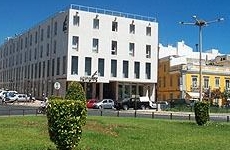The walls that surrounded the town in Moorish and medieval times.
The vestiges of the past still to be seen in churches and museums. The
refreshing verdure of a garden beside the lagoon and the sea. The outline
of noble residences that bear witness to Faro's splendour in centuries
past. Narrow streets of whitewashed houses that recall the town's Moorish
heritage. These are among the sights to be savoured on a walk around
Faro, a city where there is lots to see, to enjoy and to remember.
 Vila-Adentro
Vila-Adentro
This monumental arch, inaugurated in 1812, was built to a design
by the Italian architect Francisco Xavier Fabri over one of the medieval
gates set into the ramparts. It has a niche with a statue of Saint Thomas
Aquinas that is of Italian origin.
 Hermitage
of Nossa Senhora do 0 (Our Lady of O) Hermitage
of Nossa Senhora do 0 (Our Lady of O)
Situated on the ramparts, this chapel was rebuilt after the earthquake
of 1755 and has an interesting facade.
It is probably here, during the period of Moorish rule, that a statue
of the Virgin mentioned in one of the Canticles of Santa Maria written
by King Alfonso X of Castile was kept. |
|
 |













